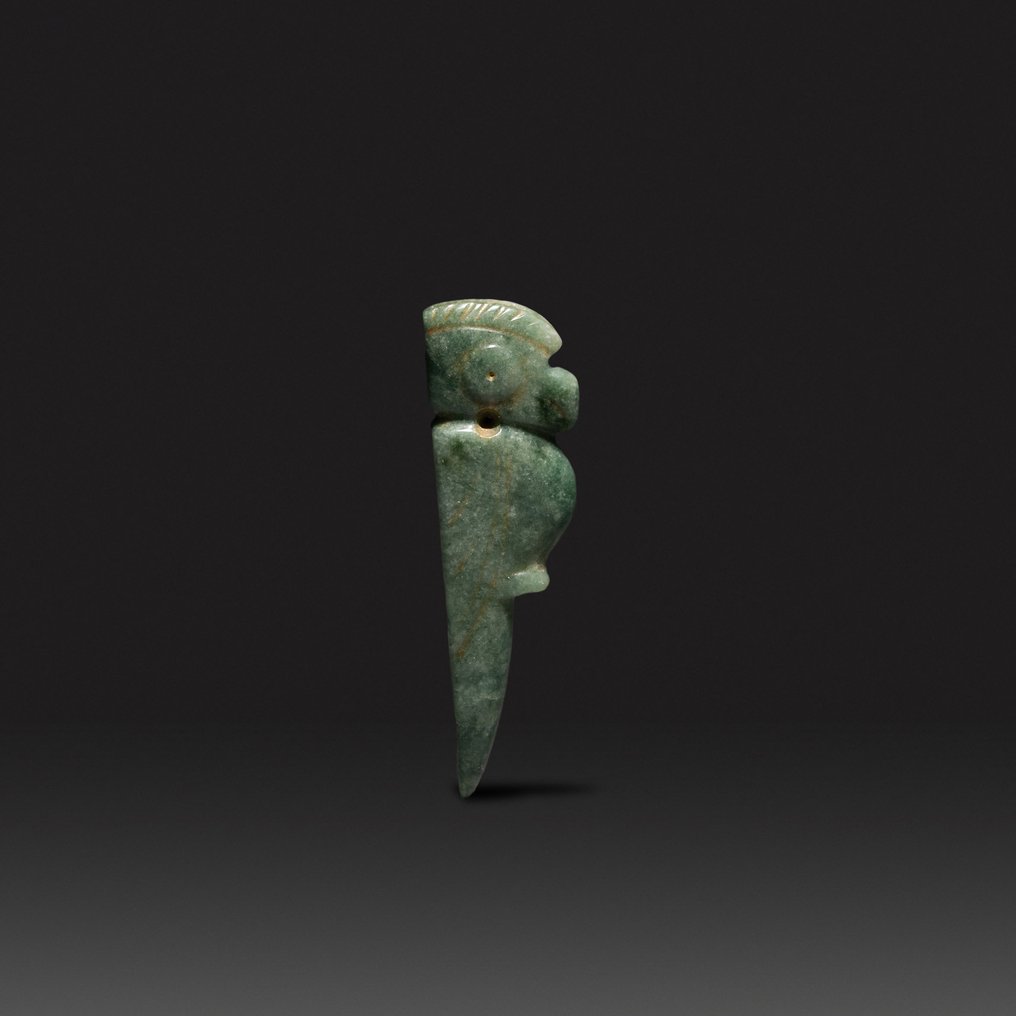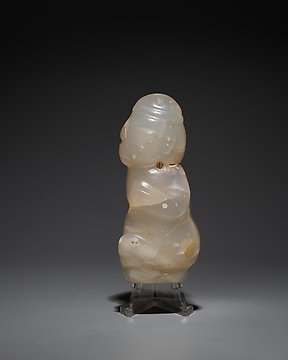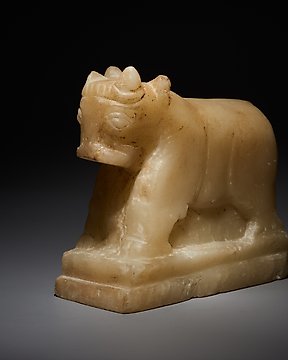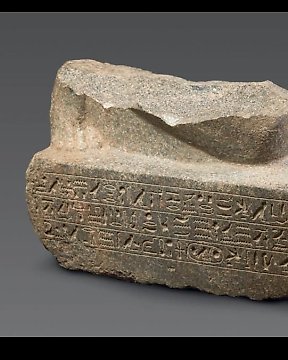All well! Thanks.
Übersetzung ansehenNicoya - Guanacaste, Jade Aviförmiger Anhänger, ca. 300 - 500 n. Chr. 10 cm. Spanische Exportlizenz.
Nr. 84870735



Aviform pendant.
- Important Piece! -
- Export License -
- Intact -
Nicoya - Guanacaste, Costa Rica. c. 300 - 500 AD.
Jade stone.
10 cm length.
PROVENANCE:
- Private collection, USA
- Banks - Primitive Inc., Maryland, USA, September 30, 1994.
- Private collection, Remy Rey, London, United Kingdom. Acquired from the previous one.
CONDITION: Intact.
BIBLIOGRAPHY:
- FERNÁNDEZ, P.; ALVARADO, G.E. Artisans and Stones: Pre-Columbian Tools and Sculpture in Costa Rica. Central Bank of Costa Rica Museums Foundation. 2006.
- FERRERO, L. Pre-Columbian Costa Rica: archeology, ethnology, technology, art. Costa Rica Publishing. 2000.
DESCRIPTION:
A pendant carved in jade (jadeite) in a rounded bulge, with a flat back edge. The design is composed of two equal profiles, with a standing bird with long folded wings, which fall on its back. The differentiated head has an upper protuberance representing a crest of feathers, a short beak and large rounded eyes with a central incision, which probably originally served to attach a decorative element made of another material, perhaps precious metal or shell. The body is small in proportion to the head, and is characterised by a convex profile at the top. The suspension holes are located at the junction between the body and the head, and their arrangement indicates that the piece would have hung showing the front of the animal, the narrower carved side of the pendant.
In Mesoamerica, jade necklaces were objects of great symbolic importance on a ritual and social level, a material representation of the high rank of their wearers. They were therefore used exclusively by chiefs, nobles and priests, as well as their families. These necklaces usually combined beads of different designs with a central pendant arranged vertically, carved to represent a human or animal figure, with the limbs folded over the belly, or in the form of a flat-edged axe, of a symbolic nature. There are also mixed representations that combine a flat, lower-edged axe structure with an upper part carved with the features of a character or animal (usually birds). These pendants were usually pierced on the sides, so that they hung frontally.
Green-coloured stone was considered sacred in Mesoamerica; it was associated with water, the fertility of maize and life, and thus linked to the preservation of the agricultural cycle. The most prized of these stones was jade (jadeite), considered more valuable than gold and a key religious, political and economic material throughout the region. It was reserved for the adornment of gods and kings, and even the latter could only wear it on certain occasions. Considered to be a symbol of life and purity, jade was used in particular to make jewellery such as pendants, nose rings and ear flares. Jadeite pendants were therefore highly valued objects, charged with symbolic and religious significance and only displayed by the most powerful members of society.
Jadeite is an extremely dense rock, with a relative hardness value equivalent to that of steel. Occasionally it is translucent, and its surface acquires greater chromatic intensity, as well as exceptional lustre and smoothness, after a prolonged process of weathering, polishing and burnishing. The only known source of jadeite in ancient Mesoamerica is in the valley of the Motagua River in present-day Guatemala. The first jadeite was probably found there in the form of boulders, before systematic extraction began.
Greater Nicoya is an archaeological region covering northwestern Costa Rica and the Pacific coast of Nicaragua. The Southern Sub-region, or Guanacaste, occupies the Nicoya Peninsula, the Tempisque River basin and the Guanacaste and Tilaran mountain ranges. It is an area that has been occupied by humans for some 10,000 years, with important remains of material culture in ceramics, carved stone and jade from the Tempisque period (500-300 BC). In the Bagaces period (300-800 AD) there was already a complex social organisation reflected in a greater variety of burial formulas, which included the use of large stone blocks. Around 800 AD, the territory of Guanacaste was occupied by Chorotega groups from the north, from the Valley of Mexico, who were fleeing Olmec domination. This migration brought the cultural influence of the Maya and formed the seed of the Kingdom of Nicoya, one of the main pre-Columbian chiefdoms in Mesoamerica at the time of the arrival of the Spanish.
Notes:
- The piece includes authenticity certificate.
- The piece includes Spanish Export License.
- The seller guarantees that he acquired this piece according to all national and international laws related to the ownership of cultural property. Provenance statement seen by Catawiki.
Der Verkäufer stellt sich vor
Aviform pendant.
- Important Piece! -
- Export License -
- Intact -
Nicoya - Guanacaste, Costa Rica. c. 300 - 500 AD.
Jade stone.
10 cm length.
PROVENANCE:
- Private collection, USA
- Banks - Primitive Inc., Maryland, USA, September 30, 1994.
- Private collection, Remy Rey, London, United Kingdom. Acquired from the previous one.
CONDITION: Intact.
BIBLIOGRAPHY:
- FERNÁNDEZ, P.; ALVARADO, G.E. Artisans and Stones: Pre-Columbian Tools and Sculpture in Costa Rica. Central Bank of Costa Rica Museums Foundation. 2006.
- FERRERO, L. Pre-Columbian Costa Rica: archeology, ethnology, technology, art. Costa Rica Publishing. 2000.
DESCRIPTION:
A pendant carved in jade (jadeite) in a rounded bulge, with a flat back edge. The design is composed of two equal profiles, with a standing bird with long folded wings, which fall on its back. The differentiated head has an upper protuberance representing a crest of feathers, a short beak and large rounded eyes with a central incision, which probably originally served to attach a decorative element made of another material, perhaps precious metal or shell. The body is small in proportion to the head, and is characterised by a convex profile at the top. The suspension holes are located at the junction between the body and the head, and their arrangement indicates that the piece would have hung showing the front of the animal, the narrower carved side of the pendant.
In Mesoamerica, jade necklaces were objects of great symbolic importance on a ritual and social level, a material representation of the high rank of their wearers. They were therefore used exclusively by chiefs, nobles and priests, as well as their families. These necklaces usually combined beads of different designs with a central pendant arranged vertically, carved to represent a human or animal figure, with the limbs folded over the belly, or in the form of a flat-edged axe, of a symbolic nature. There are also mixed representations that combine a flat, lower-edged axe structure with an upper part carved with the features of a character or animal (usually birds). These pendants were usually pierced on the sides, so that they hung frontally.
Green-coloured stone was considered sacred in Mesoamerica; it was associated with water, the fertility of maize and life, and thus linked to the preservation of the agricultural cycle. The most prized of these stones was jade (jadeite), considered more valuable than gold and a key religious, political and economic material throughout the region. It was reserved for the adornment of gods and kings, and even the latter could only wear it on certain occasions. Considered to be a symbol of life and purity, jade was used in particular to make jewellery such as pendants, nose rings and ear flares. Jadeite pendants were therefore highly valued objects, charged with symbolic and religious significance and only displayed by the most powerful members of society.
Jadeite is an extremely dense rock, with a relative hardness value equivalent to that of steel. Occasionally it is translucent, and its surface acquires greater chromatic intensity, as well as exceptional lustre and smoothness, after a prolonged process of weathering, polishing and burnishing. The only known source of jadeite in ancient Mesoamerica is in the valley of the Motagua River in present-day Guatemala. The first jadeite was probably found there in the form of boulders, before systematic extraction began.
Greater Nicoya is an archaeological region covering northwestern Costa Rica and the Pacific coast of Nicaragua. The Southern Sub-region, or Guanacaste, occupies the Nicoya Peninsula, the Tempisque River basin and the Guanacaste and Tilaran mountain ranges. It is an area that has been occupied by humans for some 10,000 years, with important remains of material culture in ceramics, carved stone and jade from the Tempisque period (500-300 BC). In the Bagaces period (300-800 AD) there was already a complex social organisation reflected in a greater variety of burial formulas, which included the use of large stone blocks. Around 800 AD, the territory of Guanacaste was occupied by Chorotega groups from the north, from the Valley of Mexico, who were fleeing Olmec domination. This migration brought the cultural influence of the Maya and formed the seed of the Kingdom of Nicoya, one of the main pre-Columbian chiefdoms in Mesoamerica at the time of the arrival of the Spanish.
Notes:
- The piece includes authenticity certificate.
- The piece includes Spanish Export License.
- The seller guarantees that he acquired this piece according to all national and international laws related to the ownership of cultural property. Provenance statement seen by Catawiki.
Der Verkäufer stellt sich vor
- 750
- 6
- 0
Vendeur très professionnel, top +++×
Übersetzung ansehenPhotos trop contrastées pour bien percevoir les défauts, mais ces défauts étaient visibles pour autant. Le "Bon état" est trompeur. Sinon, envoi rapide et correctement emballé. Frais de port exagérés.
Übersetzung ansehenGreat communication, delivery and product. Came with a well made certificate of authenticity and good packaging. Overall very happy with the purchase! Delivery is a bit expensive, but I recommend it
Übersetzung ansehenMagnifique témoin du passé, envoyé avec tous les justificatifs, impeccable. Encore une fois très satisfait, un grand merci
Übersetzung ansehenThank you for the Special offer and the fast shipping of this excellent piece of art!
Übersetzung ansehenvery good description of the object, very good price for this rare item,. Fast sending (has been at my place 2 days after buying!). Definitely would buy again.
Übersetzung ansehenSehr schön
Übersetzung ansehenAs described, perfect logistic
Übersetzung ansehengreat seller, everything came as should with certificate of authenticity
Übersetzung ansehenExceptionally well packaged, description aligned with positing received
Übersetzung ansehenReally precious, but without sound...
Übersetzung ansehenPainting well packed and rapidly sent!
Übersetzung ansehensempre grande rapidità e professionalità
Übersetzung ansehenparfait bien reçu, merci
Übersetzung ansehenVery satisfied with the small Greek Lekythos. As always (we have already bought several items from Bagot), the object was wrapped and sent immediately and with the greatest care.
Übersetzung ansehenPerfect, excellent condition, good packaging, the parcel arrived without any problems… all is perfect as usual. Thank you very much and wait for an other nice piece like this one. Gilles.
Übersetzung ansehen+++ Top vendeur professionnel comme d'habitude
Übersetzung ansehenEmbora o custo de transporte esteja acima da média foi, realmente, muito bem executado e em embalagem cuidada. Expeditos e profissionais. Recomendo
Übersetzung ansehenSnel en correct en goed verpakt verzonden
Übersetzung ansehenoggetto bellissimo, fedele alla descrizione, venditore affidabile
Übersetzung ansehenVery nice piece and fast delivery
Übersetzung ansehenEverything ok, top seller! Thank you again!
Übersetzung ansehenvery beautiful and fast shipping!thank you!
Übersetzung ansehenExcelent, very good piece++++
Übersetzung ansehen








